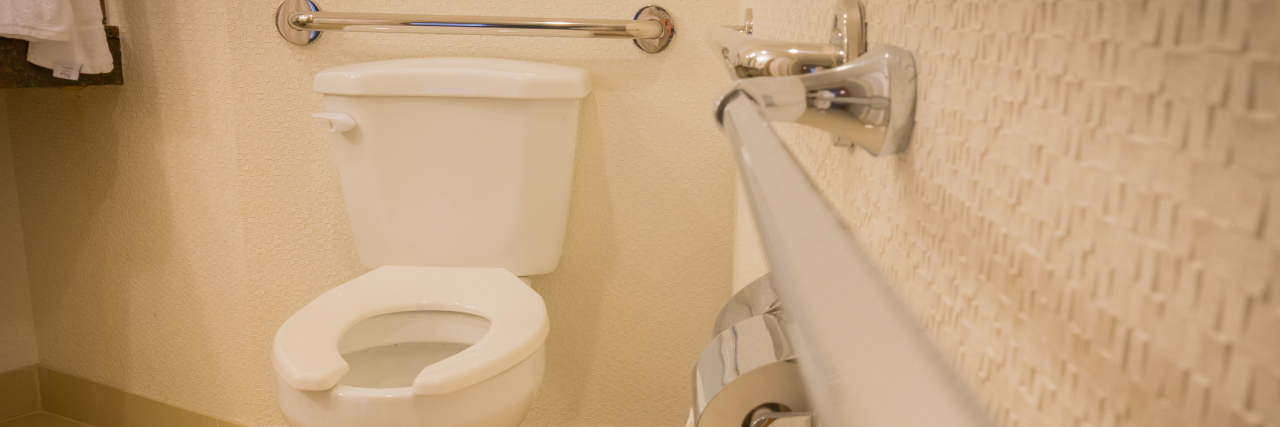I sit on a toilet seat as I had many times before inside a public restroom at the University of Arizona. Unable to safely move, I wonder what I should do next, weighing the pros and cons of each decision. There are not many pros. Twenty minutes have passed since I entered the restroom on a hot and dry Sunday afternoon.
I arrive in the bathroom and approach the accessible bathroom stall, the only one in the men’s room. It is more spacious than the other stalls and equipped with a metal grab bar on the left side of the wall and open space on the right side. More often than not, the toilet is cleaner than the others in the restroom. It also smells less vile than the others.
The bathroom had four slender bathroom stalls and the accessible stall I used frequently. That day, a man who arrives before me stands in the path of the accessible stall. I am certain he is able-bodied based on what happens next. At the time all the stalls were available. I notice the man looking down at the ground, examining each stall for cleanliness. After a few seconds, he locks eyes with me while I am sitting in my manual wheelchair, enters the accessible stall and closes the door.
Full of urine and with my body ready to release it, I contemplate my options. I decide to enter one of the regular size bathroom stalls. Born with spastic quadriplegic cerebral palsy, I have been a full-time manual wheelchair user since age 10. I had always struggled with keeping my balance without the aid of another person or a device like a grab bar. Even after years of physical therapy, which continues today when insurance and time allow, I am still at risk when transferring to areas without a supportive device.
Not wanting to urinate on my body and wheelchair seat cushion, fearing social alienation and risk of infection, I decide to transfer onto a toilet in one of the regular-sized stalls. My wheelchair fits inside, but there is no room to close the door. I angle my wheelchair slightly to the right side because I have more mobility when pivoting to the left. I lock my brakes, remove my seat belt and push down on my footplate to lift my hips. I could lower my pants to my ankles. Next, I slide my body to the edge of my seat and place both feet on the ground. I set my left hand on the toilet seat and my right hand on the seat cushion. After taking a breath to relax my body, I make my way onto the toilet seat and accomplish what I am there to do.
The man who had entered the accessible stall is gone now, but it was too late regardless. After eliminating as my body required it was time to get back into my wheelchair. A lack of confidence sweeps over me. I realize that trying to get back into my wheelchair independently and unsupervised would be dangerous.
Moments later, a man enters to use the restroom. Knowing it was mandatory that I not attempt a transfer back to my wheelchair, I accept that I will need to ask the stranger for help. Before I do, I wait for another person to enter. I do not want the individual to take advantage of my vulnerable position. I need someone else to be in the room in case I have to yell for help if the helper shows signs of aggression toward me. The man is on the toilet for an extended period. While he was occupied, another man enters the restroom. Now was my opportunity to request assistance.
I wait for the first person to finish. With my pants still down, I build the courage to ask him for help. He agrees, and I explain what to do. He helps me without incident, and I am back in my wheelchair, free to leave the restroom.
I tell this story because that restroom stop presented multiple dangerous but avoidable situations. Had the first man chosen another stall, I would have used it safely and efficiently. However, his decision to put his comfort ahead of my safety forced me to put myself at risk. If I would have held it in, I would be at risk for infection or would have urinated on myself. If I had tried to put myself back in my wheelchair, I would be at risk for breaking bones, concussion and other injuries.
I chose to allow a person I had never met inside my stall. He had to remove the wheelchair. There was not enough room for the wheelchair and two men. Something had to give. In my case and at this point in my life, not having access to my wheelchair is the same as not having legs. I had to put my safety and life in the hands of a stranger.
I ask the public to be more mindful of individuals in situations such as mine when using a public restroom. It could mean the difference between life and death.
Getty image by Galzpaka.

